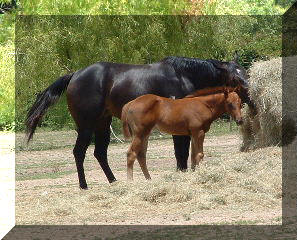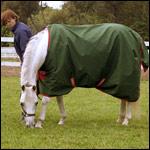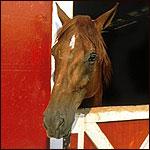| Horses are herbivores, so what better way to care for their health than through the use of herbs.
Herbs have traditionally been used in the management of equine health as part of the pasture in the form of hedge rows, dried herbs added to feed, herbal teas added to both feed and drinking water and tinctures administered in the same way or directly into the mouth. As horse owners look for a more holistic approach to equine health management, they are beginning to realize the value of traditional herbs. The movement within human health care to look for more natural ways to manage health is following strongly into animal care. Animal caregivers are realizing that chemicals are not the answers to all ailments, and as such they are looking for a more natural approach in caring for their best friends. Herbs, Tissue Salts, Flower Essences and Natural Nutrition combine to rebalance the biology of the horse, and used in conjunction with veterinary care, assist in prevention and treatment of ill-health. HERBAL REMEDIES --Aromatherapy, Feed Supplements Animals have a natural ability to self-medicate. In the wild if a horse felt ill it would find the plant or herb it needed, picking it's own medication. Due to domestication, animals can no longer do this. A trained equine aromatherapist will offer various essential oils for the horse to inhale from their hands - the essential oil used will be dependant on which one the horse prefers. Essential oils should not be taken internally, and apart from lavender should not be used neat (not diluted) - but either with a carrier oil (such as sunflower or almond), or in a water-based gel. Herbs have a variety of effects including - antiseptic, anti-inflammatory, sedative or stimulant. By being aware of each plant's properties, and used carefully the animal can be relieved of various symptoms or illnesses. In general all essential oils have the ability to strengthen the immune system, and are detoxifying. Essential oils can be used as preventative treatment - regular massage before and after work will encourage optimum performance, prevent injuries and increase bonding between you and your horse. A trained equine aromatherapist will only work with the vet's referral or permission, as an aromatherapist isn't trained to diagnose problems. Various herbs and plants that can be used are - Basil, Lavender, Garlic, Aloe Vera, Seaweed, Nettle, Rosemary, Tea Tree, Dandelion and Licorice. Basil has expectorant and antibiotic/antiseptic properties. Lavender is a relaxant. Garlic is antiseptic, antibiotic and expectorant. The expectorant properties make garlic excellent for the respiratory system. The juice from a bulb of garlic can be used on cuts and bruises. Aloe Vera is related to garlic and has anti-inflammatory, analgesic, anti-viral and anti-bacterial properties. Seaweed (Kelp) is an excellent source of nutrients, it acts as in anti-rheumatic and antibiotic. As it's rich in minerals it is a useful supplement for horses that have been on poor grazing. It is best fed as a gel and not in dried form - dried seaweed can often have too much of an iodine content. Nettles have diuretic, astringent and stimulant use due to the formic acid (released when the nettle stings). Rosemary is an anti-inflammatory, antiseptic plant - horses enjoy eating their leaves. Tea Tree is an antiseptic and mild disinfectant which aids in healing and strengthens the immune system. Dandelion is used to treat kidney or liver disorders, the root stimulates the liver and the leaves act as a diruetic. Licorice can be used as an antibiotic, anti-inflammatory, demulcent, antispasmodic and expectorant herb. It is important to remember that feeding large amounts of various herbs at once is not beneficial and they should be fed with care as with all horse feed. The following herbs must not be taken internally and are only for use as Aromatherapy - Tea Tree, Lavender and Arnica. Today's horse can greatly benefit from alternative therapies, especially Herbal Therapy. Because of our living styles and the world we live in today, our horses can not benefit from roaming hundreds and hundreds of acres of lush pastureland full of beneficial herbs and grasses. Horses can no longer pick and choose tasty plants at their leisure. By feeding your horse herbs, we may hopefully be replacing a little of what he is NOT getting in his diet. Horses do love their herbal blends, and they seem to know what they need and will let us know when they feel they no longer need a certain herb. Herbs are gentle and effective, but they are medicine and should be treated as such. Herbs may work a bit more slowly than traditional medicine, but that doesn't make them any less potent. Patience is needed to allow nature to work. When feeding herbal blends to your horse, please be sure that the blends were recommended by not only a knowledgeable herbalist, but also an equine specialist. Herbs that may be safe for humans, can in turn, be quite toxic to horses. It's always better to be safe than sorry. DOCTORS TREAT BUT NATURE CURES. Never pick and feed any plant, to either yourself or your horse, that you cannot positively identify. There are a lot of "look-a-like" weeds that have extremely toxic relatives. Example: Yarrow and Hemlock. Do not pick any plants from alongside heavily traveled roads. Those poor plants are covered in auto exhaust fumes. These plants are just not healthy. Sometimes they are called, "ill herbs". Do not trespass on someone's land without asking permission first. When planting medicinal herbs, always go by the LATIN or BOTANICAL name. Do buy a good friendly identification book. Do talk to a certified equine herbalist and your veterinarian about any changes you may see in your horse. Not every part of every plant is medicinal, in fact, some parts may even be toxic if ingested. The part above ground, which refers to the "green leafy part", is the "herb." When referring to the herb, it usually means the entire upper part of the plant, including the stem and leaves. Another part of the plant that may be used is the "root." This is the actual root below ground. You may also see the term, "bark," and this refers to the bark of woody plants and trees. Another part of the herb used may be its "flowers." Almost all root and barks have to be ground up into powered form for a horse to eat it. Powdered herbs/roots tend to be more concentrated and are usually fed by the tablespoons. The green leafy herb blends, which look a lot like course cut tea, are fed by the handful or by cups. It is common to keep the course cut herbs and the root/bark powders separate as to achieve a better dosage ratio. You can feed both blends together in your horses' feed bucket. |
 |
 |
 |
 |